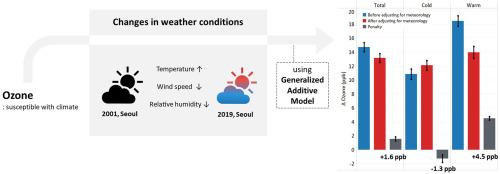利用广义相加模型评估首尔臭氧浓度和超标天数的多层次综合天气惩罚方法(2001-2019 年)。
IF 8.1
2区 环境科学与生态学
Q1 ENVIRONMENTAL SCIENCES
引用次数: 0
摘要
过去二十年来,韩国首都首尔的环境 O3 空气污染日益严重。作为一种二次空气污染物,O3 不仅受到前体气体排放的影响,还受到气象条件的影响。本研究考察了 2001-2019 年首尔天气变化对 25 个监测点测得的每日最大 8 小时臭氧浓度(MDA8 O3)长期趋势的影响。由于臭氧与气象变量之间可能不是线性关系,我们采用了广义相加模型框架来估计臭氧趋势,分别对连续臭氧数据和臭氧超标天数(>60 ppb)进行了量化回归和逻辑回归。在 19 年的时间里,首尔的臭氧浓度在根据当地气象进行调整之前和之后分别增加了 14.7(SD= 3.2)和 13.1(SD= 3.1)ppb,导致平均天气惩罚为 1.55 ppb。惩罚的季节性变化很大,显示暖季(5 月至 10 月)的惩罚(4.5 ppb)大于冷季(11 月至 4 月)。此外,在臭氧浓度相对较高的日子里,臭氧浓度的增加更为明显。在暖季,在臭氧浓度较高的日子(第 75、95 和 99 百分位数),天气对臭氧趋势的惩罚达到 3.7-4.0 ppb。从 2001 年到 2019 年,O3 超标日每年提前 2.66 天开始,推迟 2.30 天结束,O3 高峰季节总共延长了约 89 天。天气变化使臭氧超标日的几率上升趋势加快了 3.8 年。我们的研究结果表明,由于天气变化,几乎所有月份都可能出现臭氧超标日。天气对臭氧浓度和超标天数的重大影响突出表明,有必要制定一项全面的臭氧空气污染减缓战略,同时考虑在气候变化背景下日益得到认可的非排放因素。本文章由计算机程序翻译,如有差异,请以英文原文为准。

A comprehensive multi-tiered approach to assessing weather penalties on O3 levels and exceedance days in Seoul using generalized additive models (2001–2019)
Over the past two decades, ambient O3 air pollution in Seoul, the capital city of South Korea, has increased. As a secondary air pollutant, O3 is affected not only by precursor gas emissions but also by meteorological conditions. This study examined the influence of weather changes in Seoul for 2001–2019 on the long-term daily maximum 8-h O3 concentration (MDA8 O3) trends measured at 25 monitoring sites. As the relationship between O3 and meteorological variables may not be linear, we used a generalized additive model framework to estimate O3 trends, incorporating quantile and logistic regressions for continuous O3 data and O3 exceedance days (>60 ppb), respectively. Over the 19-year period, the O3 concentrations in Seoul increased by 14.7 (SD = 3.2) and 13.1 (SD = 3.1) ppb before and after adjusting for local meteorology, respectively, resulting in an average weather penalty of 1.55 ppb. Seasonal variations in the penalty were substantial, showing a greater penalty (4.5 ppb) during the warm season (May–October) than during the cold season (November–April). Furthermore, the increase in O3 concentration was more pronounced on days with comparatively high O3 levels. During the warm season, the weather penalties on O3 trends reached 3.7–4.0 ppb on high-O3 days (75th, 95th, and 99th percentiles). From 2001 to 2019, the O3 exceedance days started 2.66 days earlier and ended 2.30 days later per year, extending the peak-O3 season by approximately 89 days in total. Weather changes accelerated the upward trend in the odds ratio of O3 exceedance days by 3.8 years. Our findings indicate that O3 exceedance days can occur in nearly all months owing to weather changes. The significant weather penalties on O3 concentrations and exceedance days emphasize the need for a comprehensive O3 air pollution mitigation strategy, considering non-emission factors that are increasingly being recognized in the context of climate change.
求助全文
通过发布文献求助,成功后即可免费获取论文全文。
去求助
来源期刊

Chemosphere
环境科学-环境科学
CiteScore
15.80
自引率
8.00%
发文量
4975
审稿时长
3.4 months
期刊介绍:
Chemosphere, being an international multidisciplinary journal, is dedicated to publishing original communications and review articles on chemicals in the environment. The scope covers a wide range of topics, including the identification, quantification, behavior, fate, toxicology, treatment, and remediation of chemicals in the bio-, hydro-, litho-, and atmosphere, ensuring the broad dissemination of research in this field.
 求助内容:
求助内容: 应助结果提醒方式:
应助结果提醒方式:


